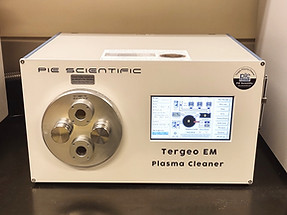Sample Preparation Equipment
Hitachi IM-3000 Flat-Ion Milling

IM-3000 is a broad ion beam milling system for flat milling of pre-polished samples. Its 1 to 6 keV Ar+ ion beam ensures limited ion implantation and high sputtering rate. Ideal for metal and alloys prior to ECCI.
LKB Nova Ultramicrotome

The LKB Nova ultramicrotome is used to prepare thin sections of soft materials of the order of 50-70 nm with a diamond knife. Perfect to prepare TEM/STEM lamella of polymers or biological materials. Does not offer the cryo option.
PIE Scientific Tergeo Plasma Cleaner

The Tergeo EM plasma cleaner can be applied on bulk specimens as well as TEM/STEM specimens mounted on the SU-9000 sample holder. It can be used in direct mode to etch/clean samples or in remote mode for a more gentle cleaning (no etching) on TEM/STEM specimens or sensitive materials.
Hitachi IM-4000Plus Ion Milling

IM-4000Plus is a broad ion beam milling system used for cross-sectioning and flat milling of various materials. It has optical systems to ensure perfect milling of surfaces and its range of acc.voltages from 1 to 6 kV, in combination to different modes of stage rotation make the IM-4000 the perfect tool for sample preparation prior to SEM. Note that it has also a air protection transfer system.
Technoorg-Linda UniMill

The UniMill broad ion beam milling system is a versatile ion polisher used to reach electron transparency on conductive specimens in the perspective of producing TEM/STEM thin specimens (3 mm). The two Ar+ guns allow high milling rates to remove quickly large layers of materials as well as low kV surface cleaning of redeposited materials and amorphized layers.
EMS Q150TS Sputter Coater/Evaporator

The Q150TS is the combination of a sputter coater and a carbon evaporator. Available targets for sputtering are: Chromium, nickel, gold, platinum. Minimum coating thickness is 1.5 nm for sputtering, 5 nm for C evaporation. Offers tilt and stage rotation.
EMS Dimpler D500i

The D500i dimpler from EMS allows to dimple 3 mm discs to reduce mechanically the specimen thickness in order to reduce the milling time to reach electron transparency of TEM/STEM samples.

